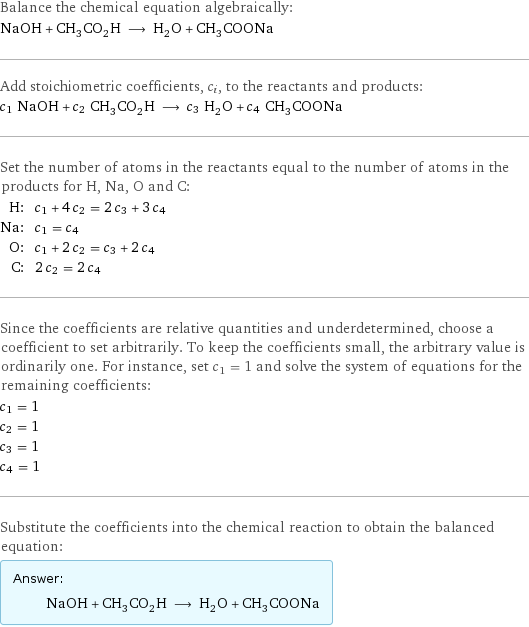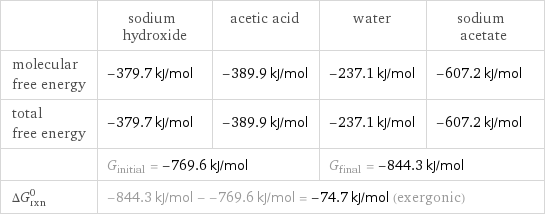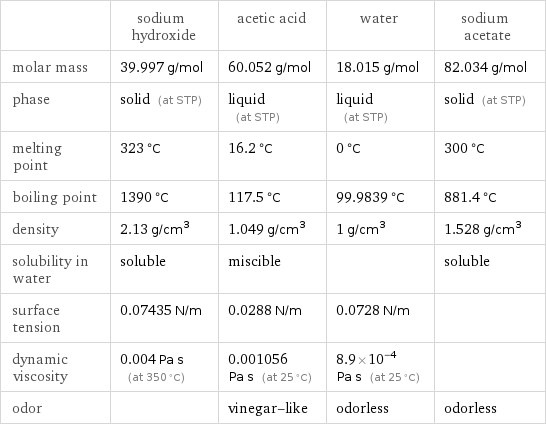Input interpretation

NaOH sodium hydroxide + CH_3CO_2H acetic acid ⟶ H_2O water + CH_3COONa sodium acetate
Balanced equation

Balance the chemical equation algebraically: NaOH + CH_3CO_2H ⟶ H_2O + CH_3COONa Add stoichiometric coefficients, c_i, to the reactants and products: c_1 NaOH + c_2 CH_3CO_2H ⟶ c_3 H_2O + c_4 CH_3COONa Set the number of atoms in the reactants equal to the number of atoms in the products for H, Na, O and C: H: | c_1 + 4 c_2 = 2 c_3 + 3 c_4 Na: | c_1 = c_4 O: | c_1 + 2 c_2 = c_3 + 2 c_4 C: | 2 c_2 = 2 c_4 Since the coefficients are relative quantities and underdetermined, choose a coefficient to set arbitrarily. To keep the coefficients small, the arbitrary value is ordinarily one. For instance, set c_1 = 1 and solve the system of equations for the remaining coefficients: c_1 = 1 c_2 = 1 c_3 = 1 c_4 = 1 Substitute the coefficients into the chemical reaction to obtain the balanced equation: Answer: | | NaOH + CH_3CO_2H ⟶ H_2O + CH_3COONa
Structures

+ ⟶ +
Names

sodium hydroxide + acetic acid ⟶ water + sodium acetate
Reaction thermodynamics
Gibbs free energy

| sodium hydroxide | acetic acid | water | sodium acetate molecular free energy | -379.7 kJ/mol | -389.9 kJ/mol | -237.1 kJ/mol | -607.2 kJ/mol total free energy | -379.7 kJ/mol | -389.9 kJ/mol | -237.1 kJ/mol | -607.2 kJ/mol | G_initial = -769.6 kJ/mol | | G_final = -844.3 kJ/mol | ΔG_rxn^0 | -844.3 kJ/mol - -769.6 kJ/mol = -74.7 kJ/mol (exergonic) | | |
Equilibrium constant
![Construct the equilibrium constant, K, expression for: NaOH + CH_3CO_2H ⟶ H_2O + CH_3COONa Plan: • Balance the chemical equation. • Determine the stoichiometric numbers. • Assemble the activity expression for each chemical species. • Use the activity expressions to build the equilibrium constant expression. Write the balanced chemical equation: NaOH + CH_3CO_2H ⟶ H_2O + CH_3COONa Assign stoichiometric numbers, ν_i, using the stoichiometric coefficients, c_i, from the balanced chemical equation in the following manner: ν_i = -c_i for reactants and ν_i = c_i for products: chemical species | c_i | ν_i NaOH | 1 | -1 CH_3CO_2H | 1 | -1 H_2O | 1 | 1 CH_3COONa | 1 | 1 Assemble the activity expressions accounting for the state of matter and ν_i: chemical species | c_i | ν_i | activity expression NaOH | 1 | -1 | ([NaOH])^(-1) CH_3CO_2H | 1 | -1 | ([CH3CO2H])^(-1) H_2O | 1 | 1 | [H2O] CH_3COONa | 1 | 1 | [CH3COONa] The equilibrium constant symbol in the concentration basis is: K_c Mulitply the activity expressions to arrive at the K_c expression: Answer: | | K_c = ([NaOH])^(-1) ([CH3CO2H])^(-1) [H2O] [CH3COONa] = ([H2O] [CH3COONa])/([NaOH] [CH3CO2H])](../image_source/899cc58de2a0d7a23286c5a9bbc8fcef.png)
Construct the equilibrium constant, K, expression for: NaOH + CH_3CO_2H ⟶ H_2O + CH_3COONa Plan: • Balance the chemical equation. • Determine the stoichiometric numbers. • Assemble the activity expression for each chemical species. • Use the activity expressions to build the equilibrium constant expression. Write the balanced chemical equation: NaOH + CH_3CO_2H ⟶ H_2O + CH_3COONa Assign stoichiometric numbers, ν_i, using the stoichiometric coefficients, c_i, from the balanced chemical equation in the following manner: ν_i = -c_i for reactants and ν_i = c_i for products: chemical species | c_i | ν_i NaOH | 1 | -1 CH_3CO_2H | 1 | -1 H_2O | 1 | 1 CH_3COONa | 1 | 1 Assemble the activity expressions accounting for the state of matter and ν_i: chemical species | c_i | ν_i | activity expression NaOH | 1 | -1 | ([NaOH])^(-1) CH_3CO_2H | 1 | -1 | ([CH3CO2H])^(-1) H_2O | 1 | 1 | [H2O] CH_3COONa | 1 | 1 | [CH3COONa] The equilibrium constant symbol in the concentration basis is: K_c Mulitply the activity expressions to arrive at the K_c expression: Answer: | | K_c = ([NaOH])^(-1) ([CH3CO2H])^(-1) [H2O] [CH3COONa] = ([H2O] [CH3COONa])/([NaOH] [CH3CO2H])
Rate of reaction
![Construct the rate of reaction expression for: NaOH + CH_3CO_2H ⟶ H_2O + CH_3COONa Plan: • Balance the chemical equation. • Determine the stoichiometric numbers. • Assemble the rate term for each chemical species. • Write the rate of reaction expression. Write the balanced chemical equation: NaOH + CH_3CO_2H ⟶ H_2O + CH_3COONa Assign stoichiometric numbers, ν_i, using the stoichiometric coefficients, c_i, from the balanced chemical equation in the following manner: ν_i = -c_i for reactants and ν_i = c_i for products: chemical species | c_i | ν_i NaOH | 1 | -1 CH_3CO_2H | 1 | -1 H_2O | 1 | 1 CH_3COONa | 1 | 1 The rate term for each chemical species, B_i, is 1/ν_i(Δ[B_i])/(Δt) where [B_i] is the amount concentration and t is time: chemical species | c_i | ν_i | rate term NaOH | 1 | -1 | -(Δ[NaOH])/(Δt) CH_3CO_2H | 1 | -1 | -(Δ[CH3CO2H])/(Δt) H_2O | 1 | 1 | (Δ[H2O])/(Δt) CH_3COONa | 1 | 1 | (Δ[CH3COONa])/(Δt) (for infinitesimal rate of change, replace Δ with d) Set the rate terms equal to each other to arrive at the rate expression: Answer: | | rate = -(Δ[NaOH])/(Δt) = -(Δ[CH3CO2H])/(Δt) = (Δ[H2O])/(Δt) = (Δ[CH3COONa])/(Δt) (assuming constant volume and no accumulation of intermediates or side products)](../image_source/4eaa34c1999f2651ff5d97829f302332.png)
Construct the rate of reaction expression for: NaOH + CH_3CO_2H ⟶ H_2O + CH_3COONa Plan: • Balance the chemical equation. • Determine the stoichiometric numbers. • Assemble the rate term for each chemical species. • Write the rate of reaction expression. Write the balanced chemical equation: NaOH + CH_3CO_2H ⟶ H_2O + CH_3COONa Assign stoichiometric numbers, ν_i, using the stoichiometric coefficients, c_i, from the balanced chemical equation in the following manner: ν_i = -c_i for reactants and ν_i = c_i for products: chemical species | c_i | ν_i NaOH | 1 | -1 CH_3CO_2H | 1 | -1 H_2O | 1 | 1 CH_3COONa | 1 | 1 The rate term for each chemical species, B_i, is 1/ν_i(Δ[B_i])/(Δt) where [B_i] is the amount concentration and t is time: chemical species | c_i | ν_i | rate term NaOH | 1 | -1 | -(Δ[NaOH])/(Δt) CH_3CO_2H | 1 | -1 | -(Δ[CH3CO2H])/(Δt) H_2O | 1 | 1 | (Δ[H2O])/(Δt) CH_3COONa | 1 | 1 | (Δ[CH3COONa])/(Δt) (for infinitesimal rate of change, replace Δ with d) Set the rate terms equal to each other to arrive at the rate expression: Answer: | | rate = -(Δ[NaOH])/(Δt) = -(Δ[CH3CO2H])/(Δt) = (Δ[H2O])/(Δt) = (Δ[CH3COONa])/(Δt) (assuming constant volume and no accumulation of intermediates or side products)
Chemical names and formulas

| sodium hydroxide | acetic acid | water | sodium acetate formula | NaOH | CH_3CO_2H | H_2O | CH_3COONa Hill formula | HNaO | C_2H_4O_2 | H_2O | C_2H_3NaO_2 name | sodium hydroxide | acetic acid | water | sodium acetate
Substance properties

| sodium hydroxide | acetic acid | water | sodium acetate molar mass | 39.997 g/mol | 60.052 g/mol | 18.015 g/mol | 82.034 g/mol phase | solid (at STP) | liquid (at STP) | liquid (at STP) | solid (at STP) melting point | 323 °C | 16.2 °C | 0 °C | 300 °C boiling point | 1390 °C | 117.5 °C | 99.9839 °C | 881.4 °C density | 2.13 g/cm^3 | 1.049 g/cm^3 | 1 g/cm^3 | 1.528 g/cm^3 solubility in water | soluble | miscible | | soluble surface tension | 0.07435 N/m | 0.0288 N/m | 0.0728 N/m | dynamic viscosity | 0.004 Pa s (at 350 °C) | 0.001056 Pa s (at 25 °C) | 8.9×10^-4 Pa s (at 25 °C) | odor | | vinegar-like | odorless | odorless
Units
